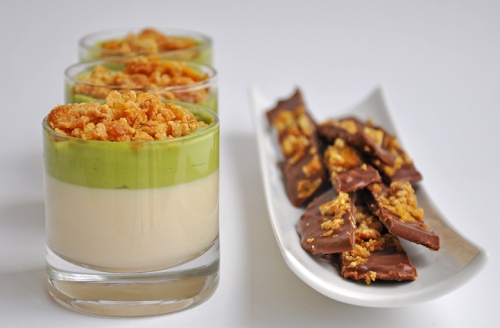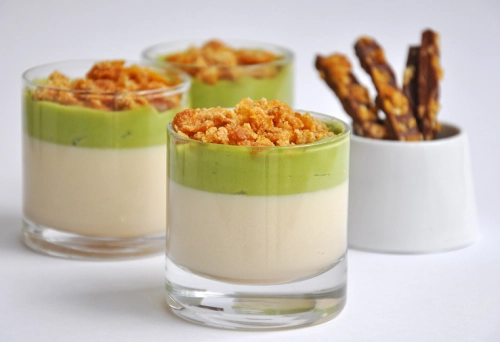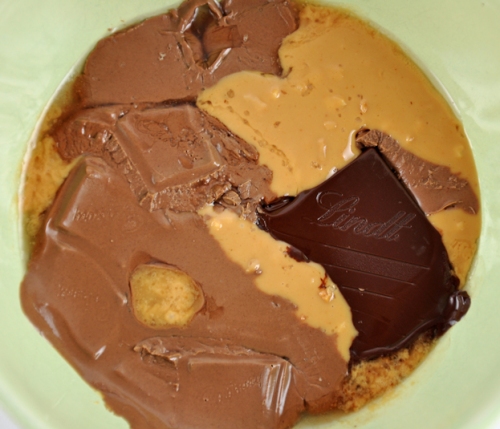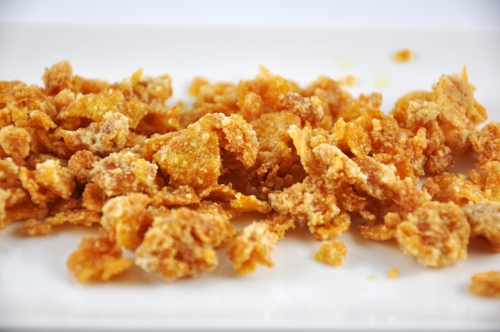Momofuku Milk Bar Pistachio Cake
Fear is not in the vocabulary of my seven month old puppy, Pash. That is, until last weekend when, for the first time, we took her on a ferry ride. As we queued to ride the ferry, you could see the anxiety in her eyes and hesitation in her steps. “Come on Pash, let’s go!” I told her impatiently – there were a number of people behind us but she refused to move. Trembling with her tail between her legs she finally inched forward behind my older, more confident dog, Baci.
I could relate. There aren’t many things that faze me in the kitchen. While I can appreciate simple home cooked meals, I like the challenge of making more complicated dishes. The more steps and techniques, the more interesting for me. It keeps me occupied.
The exception to this would be anything from Christina Tosi’s Milk Bar Cookbook, especially her layered cakes which feature enough recipes within recipes to strike fear in your heart. Every time I had a look at the cookbook I promised myself that I would try any one of the layered cakes but the minute I started reading a recipe, the heart would start racing and I’d break out in a cold sweat.
But hey, if Pash could get on that ferry – maybe I could attempt to make one of her cakes?
So here’s my attempt at facing my fear of layered cakes…. A total of four recipes – pistachio cake, lemon curb, milk crumbs and pistachio frosting is definitely not for the faint hearted.
In the end I had to make my own pistachio paste and half way through my durable thermomix refused to grind any further and there was a horrifying error message. I had to give it a rest for the night. I started early the next morning and several times during the day I asked myself whether I had taken on more than I could chew. More than 12 hours later, my kitchen looked like a war zone and I was exhausted.
But let me tell you, that cake… was worth it!
Momofuku Milk Bar Pistachio Layer Cake
Makes 1 (6-inch) Layer Cake, 5 to 6 inches tall; Serves 6 to 8
- 1 Recipe Pistachio Cake
- 65 grams Pistachio Oil
- 1 Recipe Lemon Curd
- 1/2 Recipe Milk Crumb
- 1 Recipe Pistachio Frosting
You will also need 1 (6 inch) cake ring and 2 strips acetate, each 3 inches wide and 20 inches long.
Note: Grapeseed oil can be substituted for the pistachio oil, but part of the toasted pistachio depth of flavour will be lost.
- Put a piece of parchment on the counter. Invert the cake onto it and peel off the parchment from the bottom of the cake. Use the cake ring to stamp out 2 circles from the cake, these are your top 2 cake layers. The remaining cake “scrap” will come together to make the bottom layer of the cake.
- For the first layer, clean the cake ring and place it in the center of the sheet pan lined with clean parchment. Use 1 strip of acetate to line the inside of the cake ring. Put the cake scraps inside the ring and use the back of your hand to tamp the scraps together into a flat even layer. Dunk a pastry brush in the pistachio oil and give the layer of cake a good healthy bath of half of the oil. Use the back of the spoon to spread half of the lemon curd in an even layer over the cake. Sprinkle one-third of the milk crumbs evenly over the lemon curd. Use the back of your hand to anchor them in place. Use the back of a spoon to spread one third of the pistachio frosting as evenly as possible.
- For layer two, with your index finger, gently tuck the second strip of acetate between the cake ring and the top 1/4 inch of the first strip of acetate, so that you have a clear ring of acetate 5 to 6 inches tall – high enough to support the height of the finished cake. Set a cake round on top of the frosting, and repeat the process for layer 1 (if 1 of your 2 cake rounds is jankier than the other, use it here in the middle and save the prettier one for the top).
- For layer three, nestle the remaining cake round into the frosting. Cover the top of the cake with the remaining frosting. Give it volume and swirls, or you can opt for a perfectly flat top. Garnish the frosting with the remaining milk crumbs.
- Transfer the sheet pan to the freezer and freeze for a minimum of 12 hours to set the cake and filling. The cake will keep in the freezer for up to 2 weeks.
- At least 3 hours before you are ready to serve the cake, pull the sheet pan out of the freezer and, using your fingers and thumbs, pop the cake out of the cake ring. Gently peel off the acetate, and transfer the cake to a platter or cake stand. Let it defrost in the fridge for a minimum of 3 hours (wrapped well in plastic, the cake cake be refrigerated for up to 5 days). Slice the cake and serve.
Pistachio Cake
Makes 1 quarter sheet pan cake
- 190 grams pistachio paste
- 75 grams glucose
- 6 egg whites
- 280 grams confectioners’/icing sugar
- 110 grams almond meal/flour
- 75 grams pistachio oil (can use grapeseed as a substitute)
- 55 grams heavy cream
- 160 grams flour
- 6 grams baking powder
- 6 grams kosher salkt
- Heat the oven to 175 c. Combine the pistachio paste and glucose in the bowl of a stand mixer fitted with a paddle attachment and beat on medium low for 2 to 3 minutes, until the mixture turns into a sticky green paste. Scrape down the sides of the bowl with a spatula.
- On low speed, add the egg whites one at a time, being careful not to add the next egg white until the previous one is completely incorporated. Stop the mixer and scrape down the sides of the bowl with a spatula after every 2 to 3 egg whites.
- Add the icing/confectioners’ sugar and almond meal and, on low speed, paddle them in for 2 to 3 minutes, until the mixture thickens. Stop the mixer and scrape down the sides of the bowl. Stream in the pistachio oil and heavy cream and paddle on low speed for 1 minute. Stop the mixer and scrape down the sides of the bowl.
- Add the flour, baking powder, and salt and paddle on low for 2 to 3 minutes, until the batter is super smooth.
- Spray a quarter sheet pan and line it with parchment paper. Using a spatula, spread the cake batter in an even layer in the pan. Bake for 20 to 22 minutes. At 20 minutes, gently poke the edge of the cake with your finger; the cake should bounce back and it should be slightly golden brown on the sides and pulling away from the sides of the pan ever so slightly. Leave the cake in the oven for an extra 1 to 2 minutes if it doesn’t pass these tests.
- Take the cake out of the oven and cool on a wire rack or in a pinch, in the fridge or freezer, wrapped in plastic wrap for up to 5 days.
Lemon Curd
- 3 lemons
- 100 grams sugar
- 4 eggs
- 1 gelatin sheet
- 115 grams butter, very cold
- 2 grams salt
- Zest the lemons. Put the sugar, lemon zest and 80 grams of lemon juice in a blender and blend until the sugar granules have dissolved. Add the eggs and blend on low until you have a bright yellow mixture. Transfer the contents to a medium pot or sauce pan. Clean the blender canister.
- Bloom the gelatin by placing this sheet in a bowl with cold water for a few minutes to soften.
- Heat the lemon mixture over low heat, whisking regularly. As it heats up, it will begin to thicken; keep a close eye on it. Once it boils, remove it from the stove and transfer it to the blender. Add the bloomed gelatin, butter, and salt and blend until the mixture is thick, shiny and super smooth.
- Pour the mixture through a fine mesh sieve into a heat proof container and put in the fridge until the lemon curd has cooled completely, at least 30 minutes. This can be refrigerated for up to 1 week.
Pistachio Frosting
- 115 grams butter, at room temperature
- 40 grams icing/confectioners’ sugar
- 230 grams pistachio paste
- 2 grams kosher salt
- Combine the butter and sugar in the bowl of a stand mixer fitted with a paddle attachment and cream together on medium high for 2 to 3 minutes, until fluffy and pale yellow.
- Add the pistachio paste and salt and mix on low speed for half a minute, then kick up the speed to medium high for 2 minutes. Scrape down the sides of the bowl.
- Use the frosting immediately, or store it in an airtight container for up to one week.
Milk Crumbs
Recipe can be found here.




















